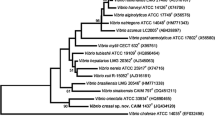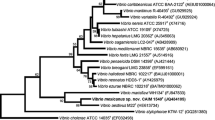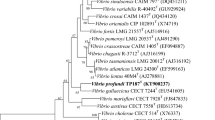Abstract
A group of four strains isolated from clams (Venerupis decussata and Venerupis philippinarum) in Galicia (NW Spain) were subjected to a polyphasic characterization, based on the phenotypic characteristics, the analysis of chemotaxonomic features, the sequencing of the 16S rRNA and five housekeeping (atpA, pyrH, recA, rpoA and rpoD) genes, as well as DNA–DNA hybridization (DDH). The analysis of the phenotypic and chemotaxonomic characteristics and the results of a phylogenetic study, based on the 16S rRNA gene sequence analysis and multilocus sequence analysis, clearly indicated that these strains belong to the genus Vibrio and were allocated between the Splendidus and Anguillarum clades showing a close relationship with the type strains of Vibrio tapetis (98.8 %), Vibrio pomeroyi (98.0 %) and Vibrio crassostreae (97.9 %). DNA–DNA hybridization results confirmed that these isolates constitute a new species. The name Vibrio cortegadensis sp. nov. is proposed with C 16.17T (=CECT 7227T=LMG 27474T) as the type strain.


Similar content being viewed by others
References
Beaz-Hidalgo R, Cleenwerck I, Balboa S, De Wachter M, Thompson FL, Swings J, de Vos P, Romalde JL (2008) Diversity of Vibrios associated with reared clams in Galicia (NW Spain). Syst Appl Microbiol 3:215–222
Beaz-Hidalgo R, Balboa S, Romalde JL, Figueras MJ (2010) Diversity and pathogenicity of Vibrio species in cultured bivalve molluscs. Environ Microbiol Rep 2:34–43
Colwell RR (2006) A global and historical perspective of the genus Vibrio. In: Thompson FL, Austin B, Swings J (eds) The biology of Vibrios. American Society for Microbiology, Washington, DC, pp 3–11
Farto R, Armada SP, Montes M, Guisande JA, Pérez MJ, Nieto TP (2003) Vibrio lentus associated with diseased wild octopus (Octopus vulgaris). J Invertebr Pathol 83:149–156
Gay M, Renault T, Pons AM, Le Roux F (2004) Two Vibrio splendidus related strains collaborate to kill Crassostrea gigas: taxonomy and host alterations. Dis Aquat Org 62:65–74
Gómez-León J, Villamil L, Lemos ML, Novoa B, Figueras A (2005) Isolation of Vibrio alginolyticus and Vibrio splendidus from aquacultured carpet shell clam (Ruditapes decussatus) larvae associated with mass mortalities. Appl Environ Microbiol 71:98–104
Goris J, Suzuki K, de Vos P, Nakase T, Kersters K (1998) Evaluation of a microplate DNA–DNA hybridization method compared with the initial renaturation method. Can J Microbiol 44:1148–1153
Jensen S, Samuelsen OB, Andersen K, Torkildsen L, Lambert C, Choquet G, Paillard C, Bergh O (2003) Characterization of strains Vibrio splendidus and V. tapetis isolated from corkwing wrasse Symphodus melops suffering vibriosis. Dis Aquat Org 53:25–31
Kim OS, Cho YJ, Lee K, Yoon SH, Kim M, Na H, Park SC, Jeon YS, Lee JH, Yi H, Won S, Chun J (2012) Introducing EzTaxon-e: a prokaryotic 16S rRNA Gene sequence database with phylotypes that represent uncultured species. Int J Syst Evol Microbiol 62:716–721
Kueh CSW, Chan KY (1985) Bacteria in bivalve shellfish with special reference to the oyster. J Appl Bacteriol 59:41–47
Lacoste A, Jalabert F, Malham S, Cueff A, Gélébart F, Cordevant C, Lange M, Poulet SA (2001) A Vibrio splendidus strain is associated with summer mortality of juvenile oysters Crassotsrea gigas in the Bay of Morlaix (North Brittany, France). Dis Aquat Org 46:139–145
Larkin MA, Blackshields G, Brown NP, Chenna R, McGettigan PA, McWilliam H, Valentin F, Wallace IM, Wilm A, Lopez R, Thompson JD, Gibson TJ, Higgins DG (2007) Clustal W and Clustal X version 2.0. Bioinformatics 23:2947–2948
Le Roux F, Goubet A, Thompson FL, Faury N, Gay M, Swings J, Saulnier D (2005) Vibrio gigantis sp. nov., isolated from the haemolymph of cultured oysters (Crassostrea gigas). Int J Syst Evol Microbiol 55:2251–2255
Leano EM, Lavilla-Pitogo CR, Paner MG (1998) Bacterial flora in the hepatopancreas of pond reared Penaeus monodon juveniles with luminous vibriosis. Aquaculture 164:367–374
Lemos ML, Toranzo AE, Barja JL (1985) Modified medium for the oxidation–fermentation test in the identification of marine bacteria. Appl Environ Microbiol 49:1541–1543
MacFaddin JF (1993) Pruebas bioquímicas para la Identificación de Bacterias de Importancia Clínica (translation by Médica Panamericana SA). Williams & Wilkins, Baltimore (in Spanish)
Nicolas JL, Corre S, Gauthier G, Robert R, Ansquer D (1996) Bacterial problems associated with scallop Pecten maximus larval culture. Dis Aquatic Org 27:67–76
Osorio CR, Collins MD, Toranzo AE, Romalde JL (1999) 16S rRNA gene sequence analysis of Photobacterium damselae and nested-PCR method for rapid detection of fish pasteurellosis. Appl Environ Microbiol 65:2942–2946
Pascual J, Macián MC, Arahal DR, Garay E, Pujalte MJ (2010) Multilocus sequence analysis of the central clade of the genus Vibrio by using the 16S rRNA, recA, pyrH, rpoD, gyrB, rctB and toxR genes. Int J Syst Evol Microbiol 60:154–165
Prado S, Romalde JL, Montes J, Barja JL (2005) Pathogenic bacteria isolated from diseased outbreaks in shellfish hatcheries. First description of Vibrio neptunius as an oyster pathogen. Dis Aquat Org 67:209–215
Pujalte MJ (2011) La familia Vibrionaceae: una actualización taxonómica. XXIII Congreso Nacional de la Sociedad Española de Microbiología, Salamanca
Pujalte MJ, Ortigosa M, Urdaci MC, Garay E, Grimont PAD (1993) Vibrio mytili sp. nov., from mussels. Int Syst Bacteriol 43:358–362
Romalde JL, Toranzo AE (1991) Evaluation of the API 20E system for the routine diagnosis of the enteric redmouth disease. Bull Eur Assoc Fish Pathol 11:147–149
Sasser M (1990) Identification of bacteria by gas chromatography of cellular fatty acids. Microbial ID Inc., Newark
Sawabe T, Kita-Tsukamoto K, Thompson FL (2007) Inferring the evolutionary history of vibrios by means of multilocus sequence analysis. J Bacteriol 189:7932–7936
Stackebrandt E, Ebers J (2006) Taxonomic parameters revisited: tranished gold standards. Microbiol Today 33:152–155
Sugumar G, Nakai T, Hirata Y, Matsubara D, Helinski DR (1998) Vibrio splendidus biovar II as the causative agent of bacillary necrosis of Japanese oyster Crassostrea gigas larvae. Dis Aquat Org 33:111–118
Tamura K, Peterson D, Peterson N, Stecher G, Nei M, Kumar S (2011) MEGA5: molecular evolutionary genetics analysis using maximum likelihood, evolutionary distance, and maximum parsimony methods. Mol Biol Evol 28:2731–2739
Thompson FL, Swings J (2006) Taxonomy of the vibrios. In: Thompson FL, Austin B, Swings J (eds) The biology of Vibrios. American Society for Microbiology, Washington, DC, pp 29–43
Thompson CC, Thompson FL, Vandemeulebroecke K, Hoste B, Dawyndt P, Swings J (2004) Use of recA as an alternative phylogenetic marker in the family Vibrionaceae. Int J Syst Evol Microbiol 54:919–924
Thompson FL, Gevers D, Thompson CC, Dawyndt P, Naser S, Hoste B, Munn CB, Swings J (2005) Phylogeny and molecular identification of Vibrios on the basis of multilocus sequence analysis. Appl Environ Microbiol 71:5107–5115
Thompson CC, Thompson FL, Vicente AC, Swings J (2007) Phylogenetic analysis of vibrios and related species by means of atpA gene sequences. Int J Syst Evol Microbiol 57:2480–2484
Ziemke F, Höfle MG, Lalucat J, Rosselló-Mora R (1998) Reclassification of Shewanella putrefaciens Owen’s genomic group II as Shewanella baltica sp. nov. Int J Syst Bacteriol 48:179–186
Acknowledgments
This work was supported in part by grant AGL-2010-18438 from the Ministerio de Ciencia e Innovación (Ministry of Science and Innovation) (Spain). A. L. acknowledges the Ministerio de Economía y Competitividad (Ministry of Economy and Competitiveness) (Spain) for a research fellowship.
Conflict of interest
The authors declare that they have no conflict of interest.
Author information
Authors and Affiliations
Corresponding author
Electronic supplementary material
Below is the link to the electronic supplementary material.
Rights and permissions
About this article
Cite this article
Lasa, A., Diéguez, A.L. & Romalde, J.L. Vibrio cortegadensis sp. nov., isolated from clams. Antonie van Leeuwenhoek 105, 335–341 (2014). https://doi.org/10.1007/s10482-013-0078-z
Received:
Accepted:
Published:
Issue Date:
DOI: https://doi.org/10.1007/s10482-013-0078-z




